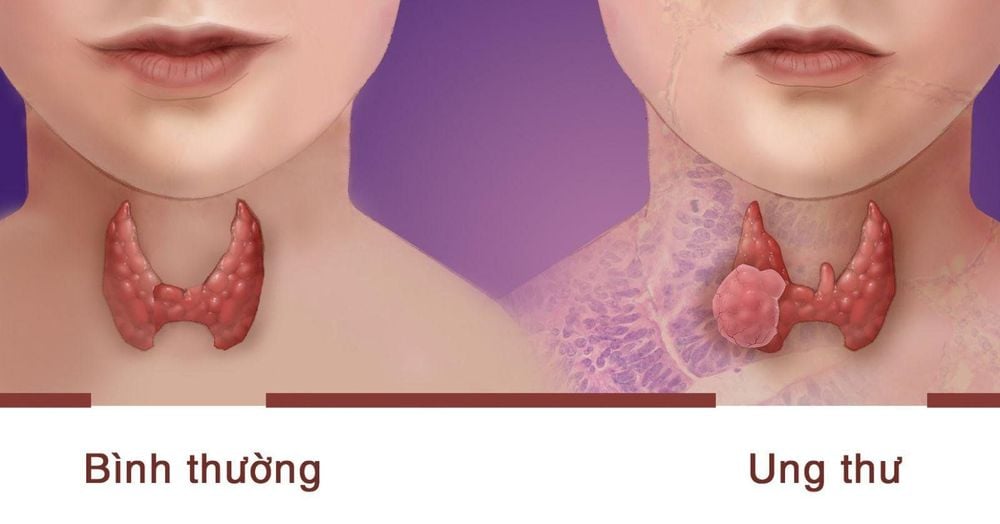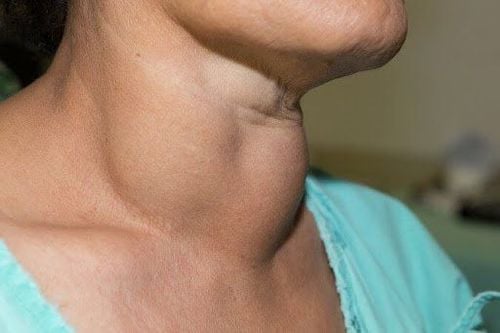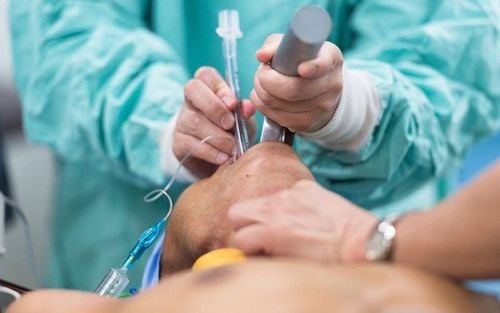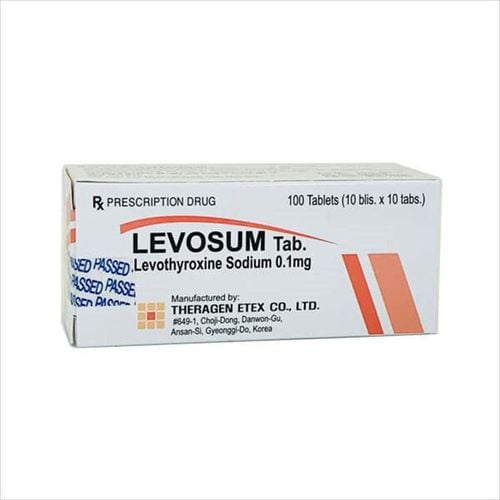This is an automatically translated article.
Thyroid cancer can be directly life threatening if detected and treated slowly. Here are some visual guides to thyroid cancer that you should be concerned about.
1. What is thyroid cancer?
The thyroid gland is a butterfly-shaped organ located in the neck that produces thyroid hormones that enter the bloodstream and travel to every cell in the body. Thyroid hormone has an important role in helping the body maintain normal functions, while keeping you warm and providing you with energy. In addition, this hormone also contributes to the support of muscle strength as well as the brain, heart and several other organs.When you have thyroid cancer, the faulty cells will grow out of control and overwhelm healthy cells. According to experts, thyroid cancer includes 4 main types, including:
papillary thyroid cancer; Follicular thyroid cancer; Medullary thyroid cancer; Undifferentiated thyroid cancer. In general, the severity of thyroid cancer will depend on the type you have and how the disease is progressing. Early treatment increases the patient's chances of survival.
2. Typical symptoms of thyroid cancer
Thyroid cancer often does not have any obvious symptoms in its early stages. The first sign is usually a small bump on the thyroid gland, but this swelling can only be detected through a CT scan or X-ray. Research says that about 90% of these nodules are benign (non-cancerous) and may require little or no treatment.
Until the disease is more advanced, thyroid cancer symptoms are more obvious and easy to see such as:
Appears a lump or swelling in the neck, especially the growth rate is very fast; Feeling pain in the front of the neck, pain spreading to the ear; The patient has a persistent cough or hoarseness for no apparent reason; Difficulty swallowing or breathing. However, these symptoms can be easily confused with conditions other than thyroid cancer. It is best to see your doctor for a specific diagnosis.

Ung thư tuyến giáp thường không có bất kỳ triệu chứng rõ rệt nào khi ở giai đoạn đầu
3. How is thyroid cancer diagnosed?
During the visit, the doctor may start a physical exam and ask you to provide some information about your family medical history. In general, to determine the cause of thyroid cancer, the doctor will perform the following diagnostic tests:
Laryngoscopy helps detect abnormal growths on the patient's larynx, such as like nodules; CT scan, MRI, or ultrasound to look for abnormalities; Biopsy by taking a sample of thyroid tissue and checking for cancer cells.
4. Differentiated thyroid cancer
Well-differentiated is the most common form of thyroid cancer, in which cancer cells tend to look very similar to other normal cells. Papillomas usually develop in one of the two lobes of the thyroid gland. Although the tumor can sometimes spread to the lymph nodes in the neck, treatment for this type of cancer has a fairly high success rate. In addition, differentiated thyroid cancer also has a cystic form when the body is iodine deficient, but it does not spread to the lymph nodes.
5. Medullary Thyroid Cancer (MTC)
Medullary thyroid cancer usually begins in the C cells in the thyroid gland. Cancer cells can spread to the liver, lungs, and lymph nodes before the disease is detected. In general, medullary thyroid cancer is a fairly rare type, including 2 types, hereditary and non-familial. With inherited MTC, parents can pass the cancer on to their children through their genes (about 25% of cases). The inherited type of MTC usually occurs in both lobes of the thyroid gland during childhood or adolescence.
6. Undifferentiated thyroid cancer
Undifferentiated thyroid cancer is a very rare form, accounting for only about 2% of all cases of thyroid cancer and usually occurs in older women. This form of cancer tends to grow and spread quickly to the neck and other parts of the body.
This type of thyroid cancer is called "undifferentiated" because the cells look completely different from normal thyroid cells. In addition, this type of cancer is also very difficult to treat, it can even develop into papilloma or cystic cancer.
7. Methods used in the treatment of thyroid cancer
Surgery is the first line of defense in cases of thyroid cancer. Your doctor may help you remove some or all of the lymph nodes or glands around the tumor, depending on the extent and type of thyroid cancer.
Usually, surgery will be indicated for cases with easily accessible tumors. However, if the tumor is large and has spread to many other places in the body, your doctor will recommend chemotherapy, radiation, radioactive iodine, or targeted therapy to treat it. for specific types of cancer cells.
8. What causes thyroid cancer?
Currently, the exact cause of thyroid cancer is still unknown. However, certain conditions can increase the risk of this type of cancer, including:
Had radiation therapy around the neck or head as a child; People between the ages of 25 and 65; Daily diet too little or iodine deficiency; Women and Asians; Have had goiter before; Personal or family history of thyroid disease/thyroid cancer; Have genetic conditions such as MEN2A, MEN2B, or FMTC.

Ung thư tuyến giáp tuỷ thường bắt đầu từ các tế bào C trong tuyến giáp
9. What to do after thyroid cancer treatment?
Immediately after surgery or other treatments to remove thyroid cancer cells, the patient needs to have a follow-up examination to see if the cancer has returned. In addition, the patient also needs to remember all appointments and notify the doctor immediately if there are any unusual symptoms. This is especially important because thyroid cancer can grow slowly again, sometimes up to 10-20 years after the first treatment.
Currently, Vinmec International General Hospital has a special Armor Screening Package. When choosing to screen and screen for thyroid diseases at Vinmec, you will be examined by experienced thyroid specialists. At the same time, you will have blood tests, evaluate the levels of thyroid function hormones such as FT3, FT4, TSH, Anti - TPO, Anti TG and ultrasound, scan to evaluate the structure of the thyroid gland. After that, when the results are returned to the doctor, you will be consulted about thyroid pathology, and discuss the appropriate treatment options for yourself. From there, thyroid disease will be prevented in time, avoiding long-term health damage in the future.
Please dial HOTLINE for more information or register for an appointment HERE. Download MyVinmec app to make appointments faster and to manage your bookings easily.
Reference source: webmd.com












